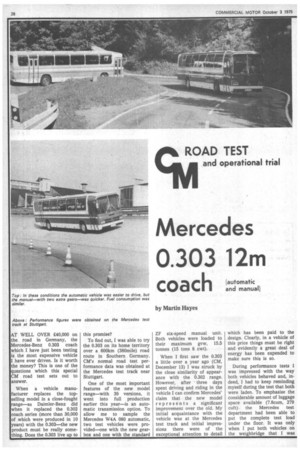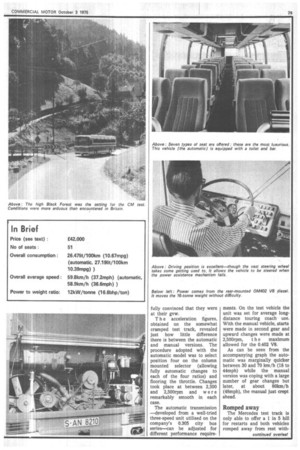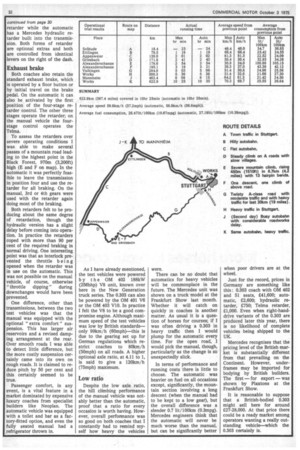0.303 12m
Page 30

Page 31

Page 32

Page 34

If you've noticed an error in this article please click here to report it so we can fix it.
coach (automatic
and manual) by Martin Hayes
Above : Performance figures were obtained on the Mercedes test track at Stuttgart.
AT WELL OVER £40,000 on the road in Germany, the Mercedes-Benz 0,303 coach which I have just been testing is the most expensive vehicle I have ever driven, Is it worth the money? This is one of the questions which this special CM road test sets out to answer.
When a vehicle manufacturer replaces the topselling model in a close-fought range—as Daimler-Benz did when it replaced the 0.302 coach series (more than 30,000 of which were produced in 10 years) with the 0.303—the new product must be really something. Does the 0.303 live up to this promise?
To find out, I was able to try the 0.303 on its home territory over a 600km (380mi1e) road route in Southern Germany. CM's normal road test performance data was obtained at the Mercedes test track near Stuttgart.
One of the most important features of the new model range—with 39 versions, it went into full production earlier this year—is an automatic transmission option. To allow me to sample the Mercedes W4A 080 automatic, two test vehicles were provided—one with the new gearbox and one with the standard ZF six-speed manual unit. Both vehicles were loaded to their maximum gvw, 15.5 tonnes (15 tons 8 cwt).
When I first saw the 0.303 a little over a year ago (CM, December 13) I was struck by the close similarity of appearance with the 0.302 range. However, after 'three days spent driving and riding in the vehicle I can confirm Mercedes' claim that the new model represents a significant improvement over the old. My initial acquaintance with the vehicle was at the Mercedes test track and initial impressions there were of the exceptional attention to detail which has been paid to the design. Clearly, in a vehicle of this price things must be right and evidently a great deal of energy has been expended to make sure this is so.
During performance tests I was impressed with the way both vehicles behaved and, indeed, I had to keep reminding myself during the test that both were laden. To emphasise the considerable amount of luggage space• available (7.8cum, 279 cuft) the Mercedes test department had been able to put the complete test load under the floor. It was only when I put both vehicles on the weighbridge that I was fully convinced that they were at their gvw.
T h e acceleration figures, obtained on the somewhat cramped test track, revealed just how little difference there is between the automatic and manual versions. The procedure adopted with the automatic model was to select position four on the column mounted selector (allowing fully automatic changes to each of the four ratios) and flooring the throttle. Changes took place at between 2,300 and 2,500rpm and were remarkably smooth in each case.
The automatic transmission —developed from a well-tried three-speed unit utilised on the company's 0.305 city bus series—can be adjusted for different performance require ments. On the test vehicle the unit was set for average longdistance touring coach• use. With the manual vehicle, starts were made in second gear and upward changes were made at 2,500rpm, t h e maximum allowed for the 0.402 V8.
As can be seen from the accompanying graph the automatic was marginally quicker between 30 and 70 km/h (18 to 44mph) while the manual version was coping with a large number of gear changes but later, at about 801un/h (48mph), the 'manual just crept ahead.
Romped away
The Mercedes test track is only able to offer a 1 in 5 hill for restarts and both vehicles romped away from rest with out difficulty. Driving controls and the general layout of the driver's cab have clearly been a subject of considerable ergonomic research. Instruments are large and easy to read, while all switches are labelled with picture symbols denoting their use. If every option is fitted there are nearly 50 such switches, Each control operates by press-on, press .off principle. Although I found the pictures easy enough to understand, I was less certain about the illumination system used.
Switches controlling items affecting safety, like the door opening mechanism, have a red light which is easy to spot when the switch is on the on position; other less important switches have a faint green illumination geared, I was told, to the needs of night driving.
Although switches which are on can also be identified because they stand proud of those around them I felt the illuminations were too faint. When I raised this point after the test with Dr Ernst Gohring, head of research, he admitted that the lighting was partly experimental. On later vehicles (both test vehicles were almost a year old) the indicator warning light, for instance, has been made much brighter and an easily audible click built into the system.
Although the braking efficiency figures we recorded were not exceptional the actual operation of the brakes on an excellent dry surface was quite adequate. No wheel locking occurred and the vehicle always pulled up without any trace of slewing. External noise tests, conducted to British Standard requirements, produced figures of 85dBA for the automatic vehicle (accelerating from 48km/h 30mph) and 85dBA for the manual under similar conditions. Inside, cruising at 80km/h (48mph) produced a reading of 70dBA at the front and 73dBA on the rear seat.
Enormous wheel
On the road section of the route it was possible to get more of the feel of the vehicles. Setting out along the autobahn from Stuttgart I first sampled the coach with manual transmission. First impressions on taking the wheel are of the enormous size of the steeringwheel itself. Almost 500mm Oft 8in) across, this is chosen because of a German regulation requiring the vehicle to be steered when the power assistance fails.
In practice the steering is very high geared — only 4% turns from lock to lock—and very light. On the motorway I thought that the steering was very little affected by strong side-winds but a little vague around the dead-ahead position.
What struck me most of all about the ZF transmission was how easy it was to use. One would think that with more than 30ft of mechanical linkage between the gear lever and the gearbox the change could not be precise. In practice, however, Mercedes engineers seem to have perfected the system to such a degree that I would rate it one of the best I have tried, even allowing for the unfamiliarity, of the lef thand-drive layout. It is certainly transformed from an 0.302 I drove some years ago.
The automatic vehicle, of course, was easier to drive. The transmission is controlled by a column-mounted selector lever. This has four forward positions. In the first position only bottom gear is used; in the second position the box will change up to second gear but not into third or top gears; in the third position first, second and third gears can be used; and in the fourth position all gears are usable. Changes are made at variable speeds, depending upon throttle position, road speed and engine torque. Down changes will only take place within maximum permitted engine speed. In practice all driving takes place in position four, except certain hill climbing when the transmission may otherwise tend to " hunt " between gears. This also occurs between 3rd and 4th, at about 40km/h (25mph).
Auxiliary braking systems are of particular importance on both vehicles. The manual coach is equipped with the Telma C115 electro-magnetic retarder while the automatic has a Mercedes hydraulic retarder built into the transmission. Both forms of retarder are optional extras and both are controlled from identical levers on the right of the dash.
Exhaust brake
Both coaches also retain the standard exhaust brake, which is operated by a floor button or by initial travel on the brake pedal. On the automatic it can also be activated by the first position of the four-stage retarder control. The other three stages operate the retarder; on the manual vehicle the fourstage control operates the Telma.
To assess the retarders over severe operating conditions I was able to make several passes of a mountain road leading to the highest point in the Black Forest, 970m (3,200ft) high (E and F on map). In the automatic it was perfectly feasible to leave the transmission in position four and use the retarder for all braking. On the manual, 3rd or 4th gears were used with the retarder again doing most of the braking.
Both retarders felt to be producing about the same degree of retardation, though the hydraulic version has a slight delay before coming into operation. In practice the retarders coped with more than 90 per cent of the required braking in normal driving. One interesting point was that an interlock prevented the throttle being opened when the retarder was in use on the automatic. This was not possible on the manual vehicle, of course, otherwise "throttle dipping" during downchanges would have been prevented.
One difference, other than transmissions, between the two test vehicles was that the manual was equipped with the optional " extra comfort " suspension. This has larger air reservoirs and a revised damping arrangement at the rear. Over smooth roads I was able to detect little difference, but the more costly suspension certainly came into its own on rough roads. It is claimed to reduce pitch by 50 per cent and this certainly seemed to be true.
Passenger comfort, in any event, is a vital feature in a market dominated by expensive luxury coaches from specialist builders like Neoplan. The automatic vehicle was equipped with a toilet and bar as a factory-fitted option, and even the fully seated manual had a ,refrigerator thrown in. As I have already mentioned, the test vehicles were powered by the OM 402 188kW (256bhp) V8 unit, known over here in the New Generation truck series. The 0.303 can also be powered by the OM 401 V6 or the OM 403 V10. In practice I felt the V8 to be a good compromise engine. Although maximum speed of the test vehicles was low by British standardsonly 99km/h (60mph)-this is due to the gearing set up for Getman regulations which restrict coaches to 80km/h (50mph) on all roads. A higher optional axle ratio, at 4.11 to 1, is said to give a 120km/h (75mph) maximum.
Low ratio
Despite the low axle ratio, the hill climbing performance of the manual vehicle was notably better than the automatic, proof that a ratio for every occasion is worth having. However, overall performance was so good on both coaches that I constantly had to remind myself how heavy the vehicles were.
There can be no doubt that automatics for heavy vehicles will be commonplace in the future. The Mercedes unit was shown on a truck model at the Frankfurt Show last month. Whether it will catch on quickly in coaches is another matter. As usual it is a question of horses for courses; if was often driving a 0.303 in heavy traffic then I would plump for the automatic every time. For the open road, I would pick the manual, though, particularly as the change is so unexpectedly slick.
In terms of performance and running costs there is little to choose. The automatic was heavier on fuel on all occasions except, significantly, the mountain section involving a long descent (when the manual had to be kept to a low gear), but the overall difference was a slender 0.7 lit/100km (0.3mpg). Mercedes engineers think that the automatic will never be much worse than the manual, but can be significantly better when poor drivers are at the wheel.
Just for the record, prices in Germany are something like this : 0.303 coach with OM 402 and 51 seats, £41,600; automatic, £2,600; hydraulic retarder, £750; Telma retarder, £1,000. Even when right-handdrive variants of the 0.303 are produced later this year, there is no likelihood of complete vehicles being shipped to the UK.
Mercedes recognises that the pricing level of the British market is substantially different from that prevailing on the Continent. However, underframes may be imported for bodying by British builders. The first for export was shown by Plaxtons at the Frankfurt Show.
It is reasonable to suppose that a British-bodied 0.303 might sell here for around £27-28,000. At that price there could be a ready market among operators wanting a really outstanding vehicle-which the 0.303 certainly is.




































































































